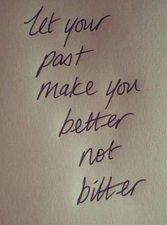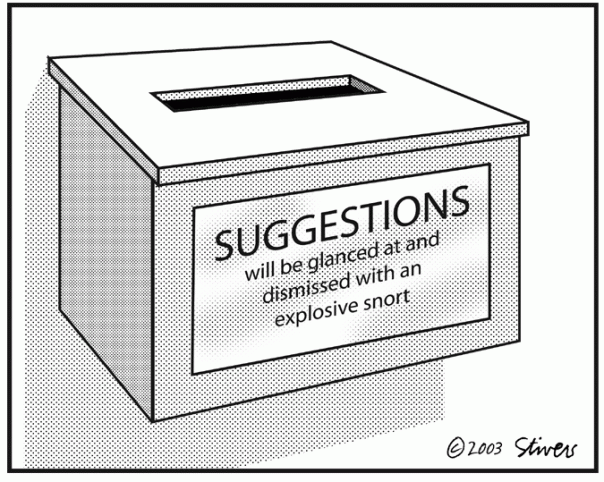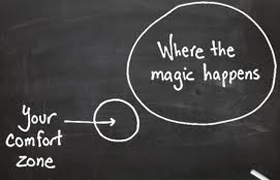 We all have that friend or partner that asks the dead end question, “Does this dress make me look fat?”, and 99.9 % of us give the answer they want to hear because deep down we know no one wants to hear the truth. The truth might be that, yes, the dress is not flattering. The dress could be the wrong color, wrong length, too tight or just plain ugly, but if you told your friend that you would probably lose a friend and receive a bill in the mail for their therapy sessions.
We all have that friend or partner that asks the dead end question, “Does this dress make me look fat?”, and 99.9 % of us give the answer they want to hear because deep down we know no one wants to hear the truth. The truth might be that, yes, the dress is not flattering. The dress could be the wrong color, wrong length, too tight or just plain ugly, but if you told your friend that you would probably lose a friend and receive a bill in the mail for their therapy sessions.
[clear]
 This happens in business too. We avoid the potential of hearing the truth because we are scared to hear the negative. When I worked at Chuck-e-Cheese I was responsible for collecting comment cards about my service as a hostess during parties. I was only 15 and super sensitive to all feedback. I dreaded reading the comment cards, and even though I aimed to please and I always felt I did my best, I took every comment personally. Sometimes I would cringe as I read the cards. I was so scared to hear that someone didn’t like me after I gave my all. The great majority of the comments loved my service and I could never understand why I was so uptight about it, but it took me years to get past the fear and to use it to my advantage.
This happens in business too. We avoid the potential of hearing the truth because we are scared to hear the negative. When I worked at Chuck-e-Cheese I was responsible for collecting comment cards about my service as a hostess during parties. I was only 15 and super sensitive to all feedback. I dreaded reading the comment cards, and even though I aimed to please and I always felt I did my best, I took every comment personally. Sometimes I would cringe as I read the cards. I was so scared to hear that someone didn’t like me after I gave my all. The great majority of the comments loved my service and I could never understand why I was so uptight about it, but it took me years to get past the fear and to use it to my advantage.
During one summer I interned at a booking agency. We were required to call clients from the weekend and ask for feedback and to rate our service. Most of the calls were not related to my event, but sometimes they were. I would swallow hard, take a deep breathe and call. I would never let the person know I was their painter, because I wanted their honest opinion. I would fill out the survey and then I would make my personal notes.
 Hearing the good, bad, and ugly helped me grow as a business person. It helped me improve my services, and think out side my box. One birthday mother said she loved me because I was early and professional, but was disappointed because I couldn’t stay an extra hour. She felt I booked my parties back to back and I didn’t leave her an option of keeping me longer. After that conversation I made it a point to keep 2 hours between events so that I had flexible room to add an extra 30 minutes at the end of a party.
Hearing the good, bad, and ugly helped me grow as a business person. It helped me improve my services, and think out side my box. One birthday mother said she loved me because I was early and professional, but was disappointed because I couldn’t stay an extra hour. She felt I booked my parties back to back and I didn’t leave her an option of keeping me longer. After that conversation I made it a point to keep 2 hours between events so that I had flexible room to add an extra 30 minutes at the end of a party.
[clear]
Another time, I spoke with a birthday mom and she said she loved my face painting but she really wanted balloons as well. I didn’t have a budget to hire both myself and a balloon artist separate, since she only had 12 girls. After that day I took a few balloon classes so that I could offer face painting and balloons to smaller parties.
Customers are looking for businesses that will increase their pleasure or decrease their pain. Work on your plan on how to incorporate those principles into your business practices. Don’t be scared of hearing something that might make you upset, instead formulate questions that will fill you with feedback that helps you grow.
If you ask the question “How did you feel about the quality of the face painting provided?”, that is the same question as asking, “Do I look fat?”. Instead try asking, “How would you rate the face painter on a scale of 1-10?”. Asking rating questions forces the person to think beyond just good and bad and assign a numerical value to their service. A great follow up question to the rating question (if the answer was not a 10) would be, “What can we do to reach a 10?” Not only does a question like this validate the customers concerns and opinion, but it might be your opportunity to gather information that can help you improve your services.
The truth doesn’t always have to hurt, it can be your best business builder.
Happy painting friends.
-Heather